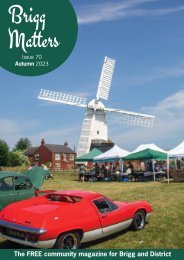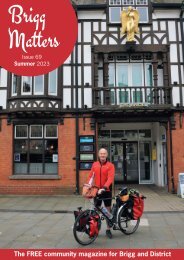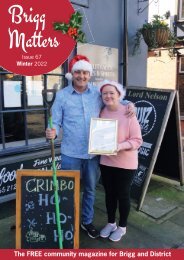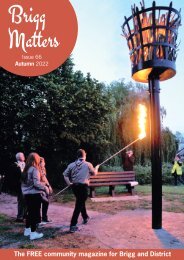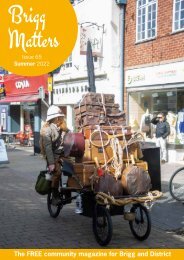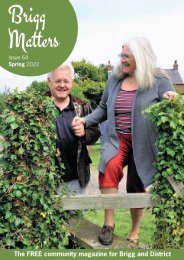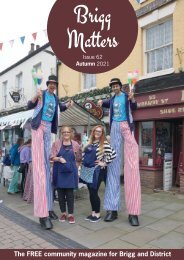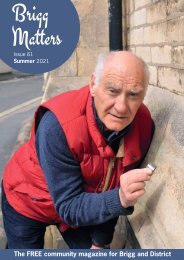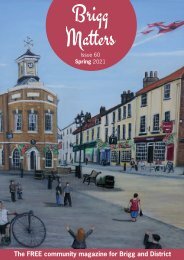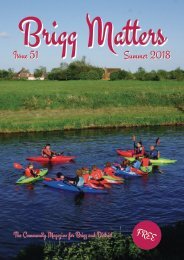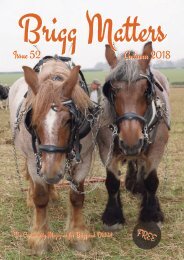Brigg Matters Issue 68 Spring 2023
Brigg Matters Magazine Issue 68 Spring 2023
Brigg Matters Magazine
Issue 68 Spring 2023
Create successful ePaper yourself
Turn your PDF publications into a flip-book with our unique Google optimized e-Paper software.
<strong>Brigg</strong> Geology Group<br />
The group’s pre-Christmas social<br />
and quiz night raised £24 from the<br />
proceeds of a raffle, the prizes for<br />
which had been kindly donated<br />
by several of those attending. A<br />
cheque for the amount raised was<br />
presented to the <strong>Brigg</strong> Servicemen’s<br />
Club on 27 th January in recognition<br />
of their continuing support.<br />
At the January meeting, Moira<br />
Smith, a recent regular attendee at<br />
meetings, brought in a collection<br />
of rocks, minerals and fossils some<br />
from her Kings Avenue garden.<br />
Amongst them were a couple of<br />
specimens that I would like to<br />
feature, the first a block of the<br />
mineral fluorspar (or fluorite)<br />
shaped to form an attractive<br />
paperweight. This is a variety known<br />
as ‘blue john’ which has bands of<br />
blue and yellow and which give it its<br />
name as it is an anglicised version<br />
of the French bleu and jaune. It was<br />
highly prized by the Romans when<br />
they discovered deposits in the<br />
caves of Derbyshire.<br />
The second specimen that caught<br />
my attention was a sea urchin<br />
(echinoid) fossil, the only members<br />
of the Animal Kingdom with 5-fold<br />
symmetry (A), which is so well<br />
preserved in flint that it can be<br />
identified to its species, Echinocorys<br />
scutata. Echinoids of this type are<br />
identified by the relative position<br />
of the mouth and anus (B) as well<br />
as general body shape. This species<br />
is typical of the Chalk and ranges in<br />
age from 92 to 66 million years ago<br />
(Late Cretaceous). I have found this<br />
species in quarries at Ulceby, Great<br />
Limber and Barrow-on-Humber.<br />
The test (shell) of this sea urchin is<br />
covered in post mortem scars caused<br />
by marine worms which have found<br />
it a useful foundation on which to<br />
secrete their tubular housing.<br />
By its state of wear, Moira’s<br />
specimen was almost certainly<br />
collected from gravels that were<br />
the product of the wearing away<br />
by Paul Hildreth<br />
Shaped block of ‘Blue John’ fluorite showing<br />
yellow (y) and purple-blue (b) veining<br />
(Scale bar = 5.5cm)<br />
Posterior view of echinoid showing its general<br />
shape and symmetry.<br />
(Scale bar = 4cm, wt = worm tube scar)<br />
Oral view of echinoid showing the relative<br />
positions of the mouth (m) and anus (a).<br />
(Scale bar = 2cm, wt = worm tube scar)<br />
of the Chalk by ice and their later<br />
deposition by meltwater. The<br />
deposits at Kettleby are an example<br />
of such chalk-flint gravels.<br />
The Yorkshire Geological Society<br />
is holding its annual ‘open day’<br />
on Saturday 29th April at the<br />
National Coal Mining Museum<br />
(NCMME) between Wakefield<br />
and Huddersfield. There will be<br />
guided tours, both surface and<br />
underground, displays, hands-on<br />
activities and a chance to have<br />
specimens identified by experts or<br />
even cut to reveal what lies within.<br />
The afternoon will also include short<br />
talks on a variety of geological topics<br />
including fish poo, fatally-bitten<br />
ammonites and how to extract tiny<br />
fossils from rocks using a pair of<br />
tights! Activities are free and aimed<br />
particularly at youngsters and family<br />
groups. There are catering facilities<br />
within the museum and ample car<br />
parking. Two of us, Mike Oates<br />
and myself will be participating,<br />
Mike with a demonstration of fossil<br />
cleaning and preparation and I shall<br />
be taking my Flamborough Head<br />
display together with a collection<br />
of fossil sponges (the subject of my<br />
January talk).<br />
Programme:<br />
Thursday 23 rd March: “Geology in<br />
<strong>Brigg</strong>” – an illustrated talk on the<br />
rocks and fossils to be found in the<br />
town’s buildings, footpaths and<br />
monuments. <strong>Brigg</strong> Servicemen’s<br />
Club, 7.45pm.<br />
Thursday 27 th April: “British<br />
Mesozoic fossils and the emergence<br />
of mammal traits” by Dr. Elsa<br />
Panciroli. A highly recommended<br />
ZOOM webinar on the early<br />
evolution of mammals organised by<br />
the Yorkshire Geological Society (I<br />
shall be on duty handling the Q&A<br />
session). Book a place by using the<br />
website (www.yorksgeolsoc.org/<br />
events) and click on the page to bring<br />
up the registration button.<br />
38 <strong>Brigg</strong> <strong>Matters</strong><br />
<strong>Brigg</strong> <strong>Matters</strong> 39




